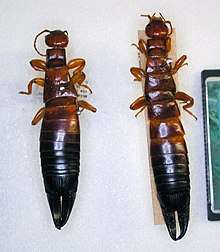Titanolabis
Titanolabis is a genus of earwigs in the subfamily Anisolabidinae (though formerly in its own subfamily).[1] It was cited by Srivastava in Part 2 of Fauna of India.[2] Among its species is the Australian T. colossea, which at about 5 cm (2.0 in) long is the largest certainly living species of earwig (the even larger Saint Helena earwig, Labidura herculeana, is generally considered extinct).[3]
| Titanolabis | |
|---|---|
 | |
| Titanolabis colossea | |
| Scientific classification | |
| Kingdom: | |
| Phylum: | |
| Class: | |
| Order: | |
| Suborder: | |
| Family: | |
| Subfamily: | |
| Genus: | Titanolabis Burr, 1910 |
| Species | |
|
See text | |
Species
The genus includes the following species:[4]
- Titanolabis bormansi Srivastava, 1983
- Titanolabis centaurea Steinmann, 1985
- Titanolabis colossea (Dohrn, 1864)
- Titanolabis gigas Steinmann, 1989
gollark: Long distance running is not very necessary to my life and I don't find it fun, so meh.
gollark: Wait, America has time zones in it too, who knows.
gollark: You are being very american.
gollark: Time zones, you know?
gollark: Which is made much better by my ability to argue about anarchoprimitivism online while remaining safely at home at some ridiculous time of night.
References
- See first entry in external links section for reference.
- Srivastava. Fauna of India, Pt. 2.
- Flindt, R. (2006). Amazing Numbers in Biology. Springer. p. 10. ISBN 978-3-540-30146-2.
- "Genus Titanolabis Burr, 1910". Australian Government Department of Environment and Energy. Retrieved 1 March 2017.
External links
| Wikispecies has information related to Titanolabis |
- The Earwig Research Centre's Titanolabis database Source for references: type Titanolabis in the "genus" field and click "search".
This article is issued from Wikipedia. The text is licensed under Creative Commons - Attribution - Sharealike. Additional terms may apply for the media files.